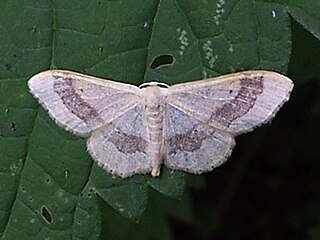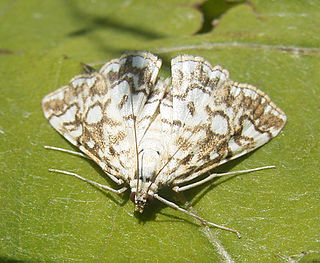| Sasunaga | |
|---|---|
| Scientific classification | |
| Domain: | Eukaryota |
| Kingdom: | Animalia |
| Phylum: | Arthropoda |
| Class: | Insecta |
| Order: | Lepidoptera |
| Superfamily: | Noctuoidea |
| Family: | Noctuidae |
| Subfamily: | Noctuinae |
| Tribe: | Dypterygiini |
| Genus: | Sasunaga Moore, 1881 |
| Sasunaga | |
|---|---|
| Scientific classification | |
| Domain: | Eukaryota |
| Kingdom: | Animalia |
| Phylum: | Arthropoda |
| Class: | Insecta |
| Order: | Lepidoptera |
| Superfamily: | Noctuoidea |
| Family: | Noctuidae |
| Subfamily: | Noctuinae |
| Tribe: | Dypterygiini |
| Genus: | Sasunaga Moore, 1881 |

Idaea, sometimes called Hyriogona, is a large genus of geometer moths. It was erected by Georg Friedrich Treitschke in 1825. They are found nearly worldwide, with many native to the Mediterranean, the African savannas, and the deserts of western Asia.

Acontiinae is a subfamily of bird dropping moths in the family Noctuidae. There are more than 50 genera and 430 described species in Acontiinae, found worldwide in temperate and tropical climates.

Omiodes is a moth genus in the family Crambidae. Several species are endemic to Hawaii.

Dichocrocis is a genus of moths of the family Crambidae. The genus was described by Julius Lederer in 1863.
Goniorhynchus is a genus of moths of the family Crambidae.
Lamprosema is a genus of moths of the family Crambidae described by Jacob Hübner in 1823.
Mimudea is a genus of moths of the family Crambidae described by William Warren in 1892.

Nacoleia is a genus of moths of the family Crambidae described by Francis Walker in 1859.
Lygropia is a genus of snout moths in the subfamily Spilomelinae of the family Crambidae. It currently comprises 66 species, which are mostly found in the tropical and subtropical regions of the Americas, Africa and Asia, but not in Australia.

Pyrausta is a speciose genus of moths of the family Crambidae. The genus was erected by Franz von Paula Schrank in 1802.

Polygrammodes is a genus of moths of the family Crambidae.

Rehimena is a genus of moths of the family Crambidae described by Walker in 1866.

Syllepte is a genus of moths in the family Crambidae.

Acontia is a genus of moths of the family Noctuidae. The genus was named by Ferdinand Ochsenheimer in 1816. Eusceptis, Pseudalypia and Spragueia are sometimes included in the present genus, but here they are tentatively treated as different pending further research. Many species of Tarache were also once placed here.

Condica is a genus of moths of the family Noctuidae. The genus was erected by Francis Walker in 1856.

Euplexia is a genus of moths of the family Noctuidae described by Stephens in 1829.
Bagada is a genus of moths of the family Noctuidae.

Macalla is a genus of snout moths. It was described by Francis Walker in 1859.

Acentropinae is a fairly small subfamily of the lepidopteran family Crambidae, the crambid snout moths. Species of this subfamily are exclusively found in wetlands and aquatic habitats.